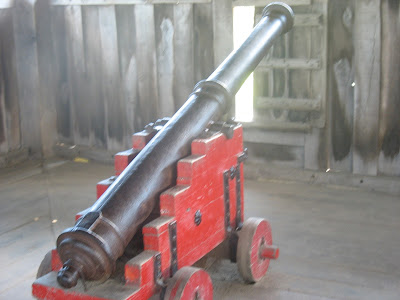On Monday we went to Plimoth Plantation in Plymouth, Massachusetts. I was really excited because they use first-person interpreters throughout the village, meaning everyone acts like a Pilgrim and they don't break out of character at all!
First we went to the Wampanoag village. The native interpreters there work in third person, so they can answer any questions people have about their lives now and in the 1600s.
I talked to a young man who was burning out a log to make a boat.
This lady was funny and I enjoyed talking to her. She was making a strap for a bag she had already woven and kept losing count.
This is the village corn field. The structure in the middle is a tower. The kids are sent to play on and around the tower and their noise keeps animals away from the corn - two birds with one stone!
Succotash - corn, beans, squash, turkey, wild onion and garlic.
Look how tall the buildings are!
Looking out from inside.
Now the Pilgrims. It is 1627, seven years after the arrival of the Mayflower.
This is a corner of the wall surrounding the village, with a raised platform to look out along the walls. This is just outside a 2-story fort that has six cannons mounted on the second floor. Apparently the cannons can fire 1 1/5 miles down into the harbor to repel pirates! The fort also serves as the meetinghouse for sabbath service.
The fort.
Looking down on the village from the fort.
We walked through a lot of Pilgrim homes.
In this period, and through at least the Revolutionary War, rugs go on tables rather than the floor.
A mustard sauce, to be served over eggs and salad. There is also a hen boiling in the smaller pot.
This fellow says he likes his life here in the colony. He has a two-room home, a good wife, and he can hunt anything he likes, unlike in England. He says the deer here are smaller, but "wery toothsome."
This is William Brewster. In England he was an official, and was a Mayflower passenger in 1620. In Plymouth Colony he is a Separatist leader and preacher.
When we arrived, Mr. Brewster was reading his Bible. I asked him if he reads the new King James Bible, which was completed in 1611. He says he "doesn't hold truck with that Bible," because it was written for preachers, not for the common man to understand. The Bible he reads, which I think was the Tyndale, has commentary included to make the text understandable to the common man. Fascinating!
Mr. Brewster's bread oven.
Look - a colander!
This man is making a 12" square wooden post. He says he can make a post in half a day. You can see a finished one behind him. Although the day was hot, when a visitor asked if it was very hard work, he replied cheerfully, "No harder than any other work."
This is so cool: Plimoth Plantation is using old breeds of animals and helping to preserve some that otherwise face extinction. They've done a lot of research to identify breeds that would be period-correct and that have as little genetic difference as possible from their forebears. These goats, for instance, come from an island off the California coast, which means they have an isolated gene pool.
Firewood mounds.
This guy told us a bit about his animals and how the community divides resources.
I can't even begin to explain how amazing this experience was. I came here primarily to see first-person interpretation in action, but I was impressed beyond even what I expected to be at the effectiveness of the technique. It feels like stepping into another century! I listened at length to a young lady tell us about cooking, medicine, family connections, relations between the separatists and the "strangers", religion and more. She spoke in a fluent period-correct accent and syntax the entire time. I asked at the visitor center about their training and was told that they begin with an intensive 2-week training, followed by a long apprenticeship, working side-by-side with another interpreter. It takes two years to become a full-fledged Pilgrim! They also have a daily study time as part of their schedule. I want to do this!!








































That was just how we all felt about visiting last year. That place is amazing. It was fun to see the familiar pictures!
ReplyDelete-Ted
Oh Ted, I found this so exciting. I'm just fascinated right now by first-person interpretation and dying to learn more and try it at Civil War events. But these interpreters know so much! Hope all's well with you and yours. A.
ReplyDeleteAutumn,
ReplyDeleteOur family gathered 'round the computer today for an hour and looked through your blog of your trip! Marvelous!
I'm related to William Brewster!
Thank you for sharing.
Margot
Margot,
ReplyDeleteThat's really cool. You'll have to go to Plimoth Plantation to "meet" him!